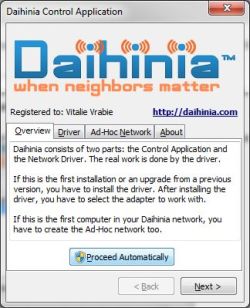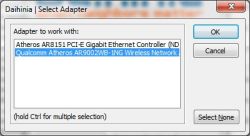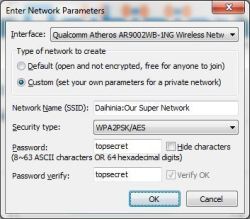Täglich bieten wir KOSTENLOSE lizenzierte Software an, die ihr sonst bezahlen müsstet!

Giveaway of the day — Daihinia 1.7.9
Daihinia 1.7.9 war am 7. Oktober 2013! als Giveaway verfügbar!
Daihinia ist ein WiFi-Tool, das einfache Ad-Hoc-Netzen zu Ad-Hoc-Mehrknotennetzen macht. Diese bieten ein höheres Flexibilitätsniveau im Vergleich zur konventionellen Infrastrukturbetriebsweise. Während sich dort alle Computer im Bereich des Zugangspunktes befinden, werden in einem Ad-Hoc-Mehrknotennetz längere Wege zwischen einzelnen Zugangspunkten möglich.
Anders gesagt gibt euch Daihinia die Möglichkeit, die Netzinfrastruktur durch die Netznutzer selbst zu unterstützen.
Im Unterschied zu anderen Lösungen für vernetzte Topologie, die diese nur für die Zugangspunkt-Einrichtungen sicherstellen, leitet Daihinia diese Funktion an Computer weiter und benötigt somit keine Zugangspunkte. Daihinia wurde als Windows-Systemtreiber kreiert und ist für alle Programme transparent.
Kommerzieller Gebrauch ist gestattet.
System-anforderungen:
Windows XP SP3, Vista SP2, 2008 SP2, W7 SP1 (x32/x64)
Herausgeber:
DaihiniaHomepage:
http://daihinia.com/Dateigröße:
7.78 MB
Preis:
$10
GIVEAWAY download basket
Kommentare zum Daihinia 1.7.9
Please add a comment explaining the reason behind your vote.
LOL.... 63% THUMBS UP in a blink of an eye without having any idea what this tool actually does....this absolutely outclasses Aieesoft's dirty tricks for good!!
This is definitely a funny forum....LOL!
To understand what this software actually does I think people need a degree in IT science + a CISCO certification in networking...LOL!
Key terms ==> Multi-hop Ad-Hoc networks + Mesh Network funcionality
http://users.ece.utexas.edu/~rheath/research/multihop
http://en.wikipedia.org/wiki/Mesh_networking
When you connect to an ACCESS POINT (Public or Private), your machine communicates only with that Access Point, even when you send data (for instance an email) to another PC in the same WiFi network: in this case data travels to the Access Point first, which then send it in the air to the target machine in the network. To make sure that everything goes smoothly all participants in the network must be in the same range of the Access Point, but if the Access Point suddenly stops working the whole network fails as a result of that.
On the other hand, there is a so called "Ad-Hoc Mode" (also called IBSS), when all PCs into a network act as a sort of PEERS with equal rights, thus sending data directly to each other without needing to communicate to the Access Point first.
So what this tool does is to add the mesh functionality directly to any networked computers, turning a simple Ad-Hoc network into a Multi-hop Ad-Hoc network, by relaying packets from one PC to another one by using a computer in the middle (for nstance when two computers are out of range for each other): this way the communication between several PCs into a wifi network will always work, even if computers are NOT in the range of the Access Point.
In other words with this GAOTD users will no longer need any Access Points to build their network, since this tool is based on WiFi's Ad-Hoc mode of operation (obviously you need a WiFi adapter capable of Ad-Hoc mode to make it work).
So overall this GAOTD could actually be a very handy tool for those who use several LAPTOPS in home and small office networks, and are eager to use them as a sort of chain or path to the central PC (Server) designed to share its wired web conection to the wireless mesh network.
BEST FREEWARE ALTERNATIVES??
Dudes...don't ask me too much...be happy with my explanation!!
You could do one thing though, namely turn your laptop into a sort of hotspot access point: why not do that for FREE??
http://www.mypublicwifi.com/publicwifi/en/index.html
http://www.connectify.me/hotspot
http://www.wifihotspotcreator.com
http://sourceforge.net/projects/movirtualrouter
Enjoy!!
benny - Can't see what looks "convoluted" to you. I know someone will want to smack me for grossly oversimplifying but basically this allows each client of the WiFi net to rebroadcast. Your machine doesn't have to pick up the signal from the router, only from the nearest machine that's connected.
For #1 Let us say your WiFi router has a maximum range of 50 meters any thing on the network that is more than 50 meters away from the router will not be able to send or receive. So far understandable what this software will do is use for example a PC on the network that is only 25 meters away from the router and use it to extend another 50 meters from the PC (in theory)so now you "boosted" to 75 meters. I hope this helps.
Can you tell us again what this does, without all the technical bumf. That has to be one of the most convoluted descriptions, without giving anything away, I've ever seen
...Getting back to TODAY's offering:
Actually it's more than just extending the range of your router. A router is used to create an infrastructure network - i.e. one base to which all computers connect. This product is used to create a special ad-hoc network i.e. a computer-to-computer network (without a router).
Now normally, if you have such a network using computers A, B, and C, then all of these computers will need to be within range of each other: A and B must be able to communicate directly, similarly B and C, also A and C.
With this product, as long as A can communicate with B and B with C, then A and C do not need to be in range of each other: B will relay the signal from A to C. Similarly, a computer D that is also not in A's range or in B's range will be able to communicate with all the computers as long as it can reach computer C. The signal can "multi-hop" through the system.
Safety issues are basically the same as other wireless networking systems (encrypted signals - which can of course be tapped into). Just remember that this system will extend the physical range of the network and technically anyone tapping into a computer way out on the periphery could have access to the whole network.
I haven't yet tested this fully, but certainly any computer expected to relay signals would need to be running the software. I don't know if a peripheral computer that can communicate with a relaying computer and still "see" the whole network using only standard Windows components.
Hope this helps.






Daihinia ist ein Ausführungsprogramm für WiFi. Es macht das einfache Ad-Hoc-Netz zum Ad-Hoc-Mehrknotennetz. Die Ad-Hoc-Mehrknotennetze stellen das höhere Flexibilitätsniveau im Vergleich zur konventionellen Infrastrukturbetriebsweise dar: in der Infrastrukturbetriebsweise müssen sich alle Computer im Bereich des Zugangspunktes befinden und im Fall des Ad-Hoc-Mehrknotennetzes müssen sie der eine im Bereich des anderen liegen, wobei sie wahrscheinlich die längeren Wege als nur eine Flugstrecke benutzen.
Anders gesagt, verkörpert Daihinia das dazwischen liegende Netzniveau, welches die Funktionen der vernetzten Topologie für die Ad-Hoc-Netze darstellt, indem es der Netzinfrastruktur durch die Netznutzer elbstunterstützt zu sein ermöglicht.
Zum Unterschied von anderen Lösungen für die vernetzte Topologie, die diese nur für die Zugangspunkt-Einrichtungen sicherstellen, legt Daihinia diese Funktion auf die Computer hin und gebraucht die Zugangspunkte überhaupt nicht. Daihinia wird als Windows-Systemdriver ausgelegt und ist transparent für die Programme.
Wer nun das Ding brauchen kann, sollte es sich kommentarlos laden, installieren und sich daran freuen. Vielen Dank!
Save | Cancel
Wer nicht weiß was dieses Tool genau tut. Beispiel: Man stecke einen Wlan-Stick an den PC. Nun kann man diesen Wlan-Stick dazu bringen das er wie ein Wlan-Router fungiert. Das heißt, es können sich mehrere PCs oder Laptops mit diesem Wlan-Stick verbinden und ihn als Internetverbindung bzw. Netzwerk nutzen. In Win7 und evtl. auch Win8 ist diese Funktion bereits enthalten und in den Netzwerkeinstellungen zu finden. Ein Ad-Hoc Netzwerk hat nichts mit einem Repeater zu tun da ein Repeater nur die Reichweite eines Routers erweitert.
Ich denke das dieses Tool eher für XP-Nutzer brauchbar wäre.
Brauchbar ist es auch dann wenn man nur einen Router ohne Wlan besitzt, dafür aber einen Wlan-Stick der dann als Internetverbindung genutzt werden kann für weitere PCs.
Ich denke dieses Tool ist auch nützlich, wenn man sich in den Netzwerkverbindungen von Win7 nicht so auskennt.
Save | Cancel
Heute fehlt mir der Durchblick. Habe nur 1 Computer = Kein echter Test moeglich. Was ein Hotspot ist weiss ich. zum Beispiel bei McDonalds.
Auf fremden Computern wird man keine Administrator-Rechte haben.
Mit den anderen Computern Ad-Hoc-Mehrknotennetze
aufbauen - da müssen doch die Gegenstellen alle mitmachen.
Also gemeinsame Besprechung, Software-Verteilung, jeder braucht eine Lizenz, Absprache über IP-Adressen, Festlegen von Verschlüsselungart und Bekanntgabe der Zugangspassphrasen. Und keiner geht nach Hause
und lässt die Verbindungskette abreissen. Daisy chain.
Interessant ist doch die Weitergabe der Internet-Verbindung
an mobile devices - also vom Computer im LAN per Wifi / WLAN
an Handys, Iphones, Ipads, Samsung Mobiles, Tablets usw.
Vielleicht schreibt ja noch ein Spezialist etwas ?
Save | Cancel
Hier kann man mal über SINN oder UNSINN von Daihinia nachlesen
http://digitalewelt.freenet.de/softwareos/internet/internetzugriff-trotz-regierungssperre--so-gehts_2356076_1055286.html
Save | Cancel
Wer braucht sowas? Oder tut sich sowas an?
Save | Cancel
Ein nützliches Tool für alle die z.B. im Garten ihr eigens WLAN nicht mehr empfangen. Der Heim-PC oder ein Notebook können als verbindendes Element dazwischen benutzt werden, um das eigene Netz quasi zu "verlängern".
Sicherlich mit Aufwand und Energiekosten verbunden, aber sicherlich praktikabler und günstiger als ein fünfzig Meter Netzwerkkabel zu spannen.
Save | Cancel
Vielen Dank, wieder eine Kreation, für die heute jede Menge Betatester gesucht werden...und ab dafür!
Save | Cancel
Ein Systemtreiber gräbt sich tief ins System ein und ist evtl. nicht mehr ohne weiteres loszuwerden. Daher unbedingt vorher Backup mit einem Imager. Und sehr viel Vertrauen zum unbekannten Hersteller! Antivirensoftware dürfte da total überfordert sein.
Nur 7.78 MB? Ist plötzlich Themida geschrumpft oder dieser Treiber alleine so groß - früher waren ganze Betriebssysteme kleiner!
Vermutlich braucht man's nur auf dem durchleitenden PC. Man braucht dann zwar keinen Repeater, muss jedoch diesen PC immer mitlaufen lassen (Stromverbrauch, Verschleiß). Und vermutlich geht's auch auf Kosten der Geschwindigkeit.
Save | Cancel
Hab ich da gleich eine Repeater-Funktion z.B. zwischen den Laptops eingebaut oder wie soll ich das verstehen? Das wär ja nicht schlecht.
Save | Cancel
Sorry, verstehe nur Bahnhof... Arbeite zwar mit einem WLAN-Netzwerk, wüsste aber nicht, was ich damit anfangen sollte. Fazit: Da mein WLAN einwandfrei läuft, werde ich das wohl kaum brauchen - aber vielleicht kann mir ja jemand erklären, welchen Vorteil mir dieses Tool bringen würde. Danke!
Save | Cancel